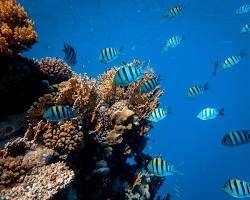Introduction:
Our planet’s ecosystems are the lifeblood of our existence, providing us with the essentials for survival and prosperity. Sadly, they’re facing immense pressure from human activities, leading to a perilous decline in biodiversity and ecosystem health. The consequences are far-reaching, impacting human health, livelihoods, and economic security.
In this critical moment, conservation efforts are more crucial than ever. Fortunately, we have a valuable ally in the fight: artificial intelligence (AI). AI offers a game-changing array of tools and techniques that can dramatically enhance our ability to protect and restore the natural world. From monitoring animal populations to predicting illegal logging activities, AI is ushering in a new era of intelligent conservation.

AI’s Arsenal for Conservation:
The potential applications of AI in conservation are diverse and constantly evolving. Here are some key areas where AI is making a significant impact:
- Monitoring and Surveillance: AI-powered cameras, drones, and satellites equipped with image recognition software can continuously monitor vast areas, tracking wildlife populations, detecting illegal activities like poaching and deforestation, and identifying environmental changes. For example, the World Wildlife Fund (WWF) is using AI to monitor endangered tigers in Nepal, helping to prevent poaching and track their movements.
- Predictive Analytics: Machine learning algorithms can analyze vast amounts of data from various sources, like sensor networks, weather patterns, and historical records, to predict future environmental changes and potential threats. This allows conservationists to proactively take preventive measures, such as relocating vulnerable species or preparing for natural disasters. The Amazon Conservation Association (ACA) is using AI to predict deforestation hotspots in the Amazon rainforest, enabling targeted interventions to protect critical areas.
- Precision Conservation: AI can guide targeted conservation efforts by identifying specific areas or species that require the most urgent attention. This allows for more efficient allocation of resources and maximizes the impact of conservation actions. The Rainforest Alliance is using AI to identify farms with the highest deforestation risk and provide them with targeted support to implement sustainable practices.
- Citizen Science and Engagement: AI can analyze data from citizen science projects, where volunteers collect environmental data, to gain valuable insights into species distribution, habitat health, and other ecological factors. This empowers the public to participate in conservation efforts and contributes to a more comprehensive understanding of environmental challenges.

AI’s Vigilant Eye: Monitoring and Surveillance in Conservation

The vastness of Earth’s ecosystems presents a major challenge for conservationists – keeping track of everything happening across sprawling landscapes and deep oceans. This is where AI-powered monitoring and surveillance come in, transforming the way we track wildlife populations, detect illegal activities, and identify environmental changes in real time.
These intelligent systems act as tireless sentinels, continuously scanning vast areas and providing valuable data to conservationists:
- Identifying and tracking individual animals: Imagine cameras equipped with facial recognition software, like the ones used in South Africa’s Kruger National Park to monitor rhinos. These systems can distinguish individual animals within a herd, allowing researchers to track their movements, study their behavior, and even identify potential threats like poachers.
- Detecting illegal activities: From deforestation in the Amazon rainforest to illegal fishing in marine protected areas, AI can analyze satellite imagery and drone footage to identify patterns and anomalies that may indicate illegal activity. This early detection allows authorities to intervene quickly and effectively.
- Monitoring environmental changes: From tracking the health of coral reefs to mapping the spread of wildfires, AI can analyze vast amounts of data from sensors and cameras to identify subtle changes in the environment. This information is crucial for understanding the impact of climate change and other environmental threats, and for informing proactive conservation measures.
Success Stories:
- WWF’s Tiger Tracking in Nepal: AI-powered camera traps with facial recognition software are helping researchers study tiger behavior, estimate the tiger population, and identify poaching threats in Nepal’s Bardiya National Park.
- Protecting Marine Mammals: The Pacific Whale Foundation uses AI-powered drones to track and monitor endangered whales off the coast of California. The drones gather data on whale behavior, health, and habitat use, which is used to inform conservation efforts and protect these majestic creatures.
Challenges and Considerations:
While AI-powered monitoring offers immense potential, it’s important to consider the challenges:
- Data Privacy: Balancing the need for comprehensive monitoring with the privacy of individuals and communities living in or near monitored areas is crucial. As technology advances and monitoring systems become more sophisticated, it’s imperative to establish robust protocols and frameworks that prioritize data anonymization, encryption, and informed consent. Implementing privacy-preserving techniques such as differential privacy, where aggregate data is utilized rather than individual-specific information, can help uphold privacy while still allowing for effective monitoring.
- Algorithmic Bias: AI algorithms trained on biased data can perpetuate harmful stereotypes and lead to unfair outcomes, especially in conservation efforts. It’s essential to ensure that AI tools used in conservation are developed and deployed ethically. This involves employing diverse and representative datasets, rigorous testing for biases at each stage of development, and implementing bias-mitigation techniques like fairness-aware algorithms and continuous monitoring for discriminatory patterns. Moreover, involving multidisciplinary teams and consulting with impacted communities throughout the AI development process can help identify and address biases more effectively.
- Accessibility and Equity: Access to AI technology and expertise in conservation efforts can be unevenly distributed, potentially widening existing inequalities. To address this disparity, efforts should be made to bridge the digital divide by providing training, resources, and support to communities that might otherwise be excluded. Collaborative partnerships between tech experts, conservationists, and community stakeholders can facilitate the transfer of knowledge and technology. Creating user-friendly interfaces and tools that cater to diverse skill sets and languages can also enhance accessibility. Additionally, initiatives aimed at fostering inclusivity and equity should prioritize the empowerment of marginalized communities, ensuring they not only have access to AI but also actively participate in decision-making processes concerning conservation strategies.
Conclusion
Our planet cries out for protection, its ecosystems threatened by our actions. In this critical hour, AI emerges as a powerful ally, offering tools to monitor, predict, and protect. From tracking elusive tigers to safeguarding coral reefs, AI’s potential is vast. Yet, challenges like data privacy and equitable access demand responsible action. Let us forge a path where AI serves humanity and nature, writing a new chapter where Earth’s ecosystems thrive. The future is in our hands, let’s choose wisely with AI as our guide.
Further Reading
- AI for Earth: 10 Breakthrough Technologies for Protecting Our Planet” by World Wildlife Fund:
- The Algorithmic Advantage: How AI Can Save the Planet” by Nature Conservancy
- Empowering Green Initiatives: AI’s Impact on Ecology and Sustainable Living
- The Rise of Intelligent Automation: Transforming Industry and Workforce with AI
